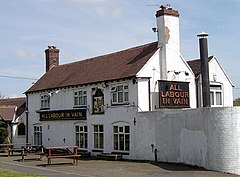Horsehay
Horsehay
Human settlement in England
Horsehay is a suburban village on the western outskirts of Dawley, which, along with several other towns and villages, now forms part of the new town of Telford in Shropshire, England. Horsehay lies in the Dawley Hamlets parish, and on the northern edge of the Ironbridge Gorge area.
This article has multiple issues. Please help improve it or discuss these issues on the talk page. (Learn how and when to remove these template messages)
|
Horsehay used to have four pubs, The Station Inn, The Forester Arms, the All Labour In Vain and the Travellers Joy, however The Station Inn closed down in 2012, and the All Labour In Vain closed in 2014. It also has a Methodist Chapel, a village hall, a post office, and a golf course complete with restaurant.

